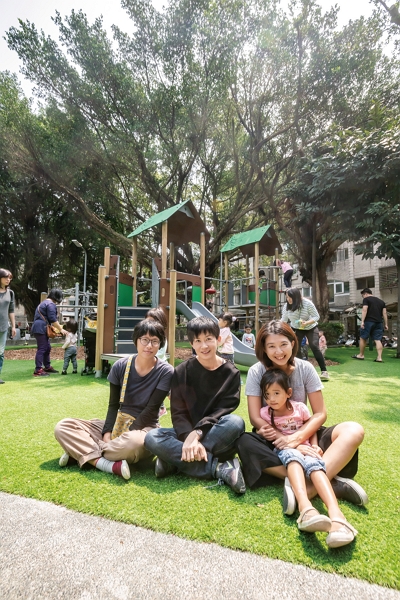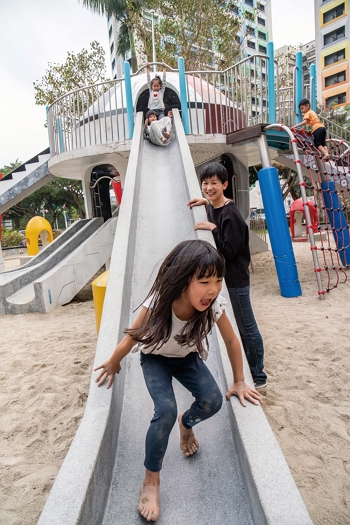New Southbound Policy Portal

Parks and Playgrounds for Children and by Children’s founder Zoe Lin (middle), secretary-general Ariel Zhang (right) and member Tsai Ching-hua (left) are working together to protect their local parks. (photo by Lin Min-hsuan)
|
|
“Back when there was just plastic play equipment, it wasn’t much fun, and my two-year-old daughter would get bored and constantly tug at my hand, saying, “Mama, play with me.” A mover and shaker behind the revamping of Taipei City’s Guling Park, Tsai Ching-hua watches her daughter Lele play happily on the monkey bars with a friend she met at the park. “It’s no longer just us coming every day,” she notes. “In the afternoon, after the elementary schools let out, and in the evening too, there are additional waves of users. A lot of the bigger kids can scamper across that net like Spider-Man and crazily spiral down the monkey bars!”
Park defendersWhen her daughter was two, Tsai took part in a walking tour of Taipei City, which introduced her to Parks and Playgrounds for Children and by Children (PPCC). She discovered that even a “full-time mother” and housewife like herself could effect change at the playground that her Lele thought wasn’t any fun.
|
|
Tsai first inquired of the neighborhood chief, who referred her to the agency responsible for the parks: the Parks and Street Lights Office (PSLO) of the Taipei City Government. She explained to the PSLO the need for a better playground at Guling Park, and she persuaded nearly 100 people in the community to sign a petition. Under the doggedly watchful eye of Tsai and other neighborhood residents, the PSLO promptly responded by placing Guling Park on the 2018 “improvements and renovations” list.
In the early spring of this year, improvements were completed at Guling at a cost of over NT$2.5 million. The playground now includes integrated jungle gyms as well as slides and other equipment, all connected by wooden frameworks.
Guling Park is but one example of PPCC’s efforts to support local residents’ calls to revamp their parks. The origins of the group, with its slogan “Your park, your responsibility,” trace back to 2015, when Taipei City tore out a series of dangerous terrazzo slides and replaced them with generic PE or fiberglass playground equipment. It was at that point that a local mother named Zoe Lin, who would go on to found PPCC, began to get angry.
|
|
Lin, who sports a pixie cut, recalls how changes to children’s playground spaces first caught her attention. “Originally, when I heard that the terrazzo slides at Taipei’s Zhixing Park and Indigenous People’s Park were getting torn down, I didn’t think anything about it. Then they also tore down the terrazzo slides in the Taipei Youth Park near my house. I called to inquire about that, and the PSLO simply replied that ‘they were torn down because they were unsafe.’”
“The Taipei Youth Park had three outstanding historical installations of playground equipment: metal slides, terrazzo slides, and a ‘space fort’ commemorating Neil Armstrong’s walk on the moon. These feature prominently in memories that are dear to many locals.” So that her daughter Xiaoxia could experience the same pleasures, Zoe Lin, who had been an assistant manager at Deloitte Taiwan before becoming a full-time mom, prepared a report with text and graphics for a Taipei City councilor representing the Wanhua District.
This “defense briefing,” which was named “Children’s Right to Play,” brought with it an emphasis on children’s rights of expression and on the power of public participation. Beginning in late 2015, the report was passed along from the city councilor to the PSLO director, then to the director of Taipei’s Public Works Department, and finally to Mayor Ko Wen-je. Listening to public opinion, the city government budgeted over NT$10 million to build more than 30 themed playgrounds. It became one of the accomplishments that Ko’s 2018 reelection campaign touted with regard to making Taipei a “child-friendly city.”
|
|
A similar situation had occurred at Daan Park, near the home of Ariel Zhang, PPCC’s secretary general. Zhang says, “In 2015, 60 of the original 76 terrazzo slides in the park were torn down for safety reasons, leaving only 16.”
Zhang had previously been a brand manager for a trading company. Feeling that the city government was handling these decisions about playgrounds in a thoughtless and perfunctory manner, she and Lin started to share their thoughts with other mothers around them and connect with them on social media. In December of 2015 nearly 100 mothers and their children held a demonstration in front of Taipei City Hall. “No generic solutions for parks!” they chanted. In this manner, they knocked on government’s door and launched the “children’s playground revolution.”
Tug of war: Safety vs. characterIn truth, City Hall was receptive and willing to cooperate. Civil servants explained that the city government had to follow relevant legal requirements, giving these enthusiastic mothers a reality check: “Does the playground equipment conform to Taiwan’s CNS safety standards? Do you want us to break the law? Do you want us to ignore children’s safety?”
To get a handle on safety regulations, these mothers would stay up at night after finishing their housework, studying relevant laws and regulations. They established small online reading groups and contacted friends in different fields, enlisting those proficient in English to translate foreign best practice guidelines, and occupational therapists and child psychologists to provide knowledge about children’s minds, education and so forth. From architects and landscape architects, they learned how to read blueprints and design drawings.
|
|
Lin and Zhang brought together other likeminded mothers to create PPCC, drawing on specialist data and knowledge to push the city government to provide children with play equipment that meets their needs for physical exercise, sensory stimulation and emotional support at different stages of their physical and mental development.
PPCC hopes that government departments and designers will consider children’s “right to participation” when making plans. It wants government to listen to children’s voices, gain understanding of how they play, and design play spaces that meet their needs.
Special playgrounds throughout TaiwanLin even went with fellow members of the group to Taichung and Kaohsiung, promoting the stands taken by PPCC with posters made on A3-size paper. They would chant, “Your park, your responsibility!” until their voices were hoarse. Soon the campaign spread to New Taipei City: “Our parks need character too!” The movement continued to attract likeminded citizens, making waves in Taoyuan, Taichung, Hsinchu, Keelung, Kaohsiung, and other locations.
|
|
Because there is generally more space available in New Taipei City, playgrounds there can be designed more to meet the needs of particular age groups and abilities than in Taipei City. Take Linkou District: Its “Bear Cub Park 23” has an inclusive playground that accommodates children of different ages to play together. LOHAS Park, on the other hand, is more challenging and thus suited to older children, with climbing nets and slides that exceed four meters in height. The youngsters scurry across the nets like squirrels.
PPCC advocates the concept of “satellite parks” located in different areas of a locality, with each park catering to the needs of a different age group, and children switching between the parks as they grow.
The streets are my playgroundYet there are many children who lack parks and playgrounds near their homes, and thus have little choice but to stay home and watch television or play video games. As an organization advocating for children’s right to play, PPCC has moved beyond its campaign to construct playgrounds in parks and has made a new appeal this year: “The street is my playground!”
Via crowdfunding, the organization is holding three activities this year around that slogan, helping children acquire more space for free play. The idea is that with a community’s support, parents can apply to “close a street” in the same way as they get closed for election rallies, art fairs or New Year’s celebrations. Children will be able to play in the street and local residents can come out and get to know each other. It can help build a sense of community.
|
|
Article 31 of the United Nations’ Convention on the Rights of the Child demands recognition of children’s right to play, because children use play to understand the world and to learn. That brings to mind an observation by professor Hideaki Amano: “If children can’t play, their souls die. Children’s souls are adults’ responsibility.”
 Different types of play equipment meet the needs of children of different ages.
Different types of play equipment meet the needs of children of different ages. In a sandbox children can dig, mold and build, creating pools and water channels as they explore the texture of the sand. It’s therapeutic and develops creativity.
In a sandbox children can dig, mold and build, creating pools and water channels as they explore the texture of the sand. It’s therapeutic and develops creativity. PPCC’s calls to fight against “generic parks” have resulted in a revolution in Taiwan’s playgrounds. (courtesy of PPCC)
PPCC’s calls to fight against “generic parks” have resulted in a revolution in Taiwan’s playgrounds. (courtesy of PPCC) Thanks to Zoe Lin’s efforts, the Taipei City Government has restored and constructed terrazzo slides to CNS standards. It’s allowed her daughter Xiaoxia to continue to enjoy the Taipei Youth Park, where Lin herself played as a child.
Thanks to Zoe Lin’s efforts, the Taipei City Government has restored and constructed terrazzo slides to CNS standards. It’s allowed her daughter Xiaoxia to continue to enjoy the Taipei Youth Park, where Lin herself played as a child. A playground’s carpet of woodchips offers children a medium through which to come into contact with nature.
A playground’s carpet of woodchips offers children a medium through which to come into contact with nature. PPCC advocates that residents should be able to apply for street closures so that children can play in the street. (photo by Chuang Kung-ju)
PPCC advocates that residents should be able to apply for street closures so that children can play in the street. (photo by Chuang Kung-ju) With cardboard boxes, wooden boards and bubbles, children can engage in all manner of outdoor fun. (photo by Chuang Kung-ju)
With cardboard boxes, wooden boards and bubbles, children can engage in all manner of outdoor fun. (photo by Chuang Kung-ju)